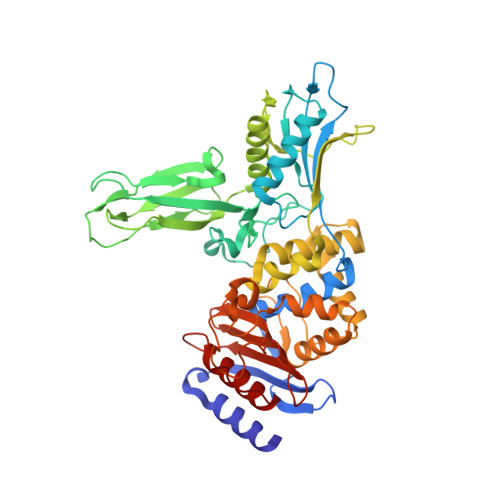Crystal Structure of a Complex between the Actinomadura R39 Dd-Peptidase and a Peptidoglycan- Mimetic Boronate Inhibitor: Interpretation of a Transition State Analogue in Terms of Catalytic Mechanism.
Dzhekieva, L., Rocaboy, M., Kerff, F., Charlier, P., Sauvage, E., Pratt, R.F.(2010) Biochemistry 49: 6411
- PubMed: 20608745
- DOI: https://doi.org/10.1021/bi100757c
- Primary Citation of Related Structures:
2XDM - PubMed Abstract:
The Actinomadura R39 DD-peptidase is a bacterial low molecular weight class C penicillin-binding protein. It has previously been shown to catalyze hydrolysis and aminolysis of small D-alanyl-D-alanine terminating peptides, especially those with a side chain that mimics the amino terminus of the stem peptide precursor to the bacterial cell wall. This paper describes the synthesis of (D-alpha-aminopimelylamino)-D-1-ethylboronic acid, designed to be a peptidoglycan-mimetic transition state analogue inhibitor of the R39 DD-peptidase. The boronate was found to be a potent inhibitor of the peptidase with a K(i) value of 32 +/- 6 nM. Since it binds some 30 times more strongly than the analogous peptide substrate, the boronate may well be a transition state analogue. A crystal structure of the inhibitory complex shows the boronate covalently bound to the nucleophilic active site Ser 49. The aminopimelyl side chain is bound into the site previously identified as specific for this moiety. One boronate oxygen is held in the oxyanion hole; the other, occupying the leaving group site of acylation or the nucleophile site of deacylation, appears to be hydrogen-bonded to the hydroxyl group of Ser 298. The Ser 49 oxygen appears to be hydrogen bonded to Lys 52. If it is assumed that this structure does resemble a high-energy tetrahedral intermediate in catalysis, it seems likely that Ser 298 participates as part of a proton transfer chain initiated by Lys 52 or Lys 410 as the primary proton donor/acceptor. The structure, therefore, supports a particular class of mechanism that employs this proton transfer device.
Organizational Affiliation:
Department of Chemistry, Wesleyan University, Lawn Avenue, Middletown, CT 06459, USA.


















